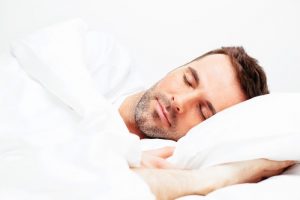The Science of Sleep in Schizophrenia

Most people will experience sleep problems at some time in their lives. (Image: Baranq on Shutterstock)
Introduction
Although insomnia or excessive tiredness are familiar to most who live with schizophrenia they are not unique to it. At least 70% of people suffer from some sleep abnormalities at some point in their lives for various reasons. Sleep problems can be the result of either a physical, mental or emotional issue that disturbs the normal rhythm of our bodies which then creates a vicious circle, as lack of sleep can have definite physical, mental or emotional implications leading to a continued cycle and a problem that is self-fulfilling.
In this information sheet we look at the science of sleep in schizophrenia. There is more information about sleep including some practical hints to help improve your sleep in our general information sheet on sleep.
Unlike people with schizophrenia, healthy individuals usually have sleep disturbances due to a transient issue rather than an organic issue. In this document we will look at the basic biology behind sleep and wakefulness generally then specifically at these processes in schizophrenia, their causes and abnormalities including treatments and techniques to combat either insomnia or excessive day time tiredness experienced by those living with schizophrenia. You may find that having a grasp of the biological mechanisms of how and why we sleep, how they work in a healthy brain and dysfunction of these mechanisms in schizophrenia is helpful. Often the reduction of what seems like an abstract concept, to its physical nuts and bolts can be of valuable therapeutic benefit in accepting and combating it. We will then discuss treatments and solutions to sleep abnormalities in schizophrenia.
The Physiology of Sleep and Wakefulness
Sleep and wakefulness are physiologically interrelated however there are definite differences in the active brain processes and neurochemical systems involved. Alertness and brain arousal are enabled by several pathways in the brain extending from the brain stem. The cells along this arousal pathway include neurons dedicated to the production, use and release of several important chemical messengers or neurotransmitters, that enable rapid communication within the brain between neurons or with the rest of the body and are essential to consciousness, wakefulness and associated behaviour. Namely, they are acetylcholine, noradrenalin, serotonin, dopamine and histamine. These cells fire in a particular pattern to promote arousal however, every 24 hours this system is inhibited during sleep. This is achieved by the actions of neurons that produce and release the inhibitory neurotransmitters gamma amino butyric acid (GABA) and galanine. The interaction between these two pathways operates like an electrical switch and allows the body to maintain either a stable sleep state or stable awake state.1

If you have problems with sleep it is important to speak to your doctor or CPN. (Image: Shutterstock)
Usually this switch design allows stability between sleep and wakefulness while promoting rapid transition between the two physical states. Sleep disorders indicate a malfunction of this switch causing sleep-wake state instability which, results in either sleep intruding on wake state and vice versa. The switch from wake to sleep requires the inhibitory influence of GABA and galanine. These have been shown to suppress the activity caused by the neurotransmitters mentioned earlier which are known collectively as monoamines, that produce the arousal state. This exchange between the monoamine arousal group of neurons and sleep inducing group of cells means that when monoamine neurons are extremely active, they inhibit the sleep pathways and when inhibitory sleep pathways fire extensively during sleep, they block the discharge of the monoamine cell group. This is known as a ‘flip flop’ or bistable circuit. The two halves of the circuit strongly inhibit each other. This produces two stable activity patterns, either ON or OFF. Any sort of intermediary states of half wake or half sleep are avoided.2
In spite of this, if either side of the circuit is either abnormal, injured or weakened, the instability occurs during both sleep and wake states. In order to promote this stability, another neurochemical called orexin exerts an influence on sleep regulation. The effect of this chemical is mainly on the arousal pathway of neurons but only modestly effects the sleep inducing pathways thus promoting wakefulness.3
It is a commonly held belief that sleep is restorative however, what is being restored is not so certain. It is believed that it is a process that allows the body to return to a balance. The maintenance of the body’s internal balance is called homeostasis and covers the regulation of, for example, blood glucose level, fluid and electrolyte balance, hormone secretion and levels and arterial blood gas values such as oxygen/carbon dioxide levels and blood pH. This explains why prolonged sleep deprivation usually requires a compensatory sleep or ‘lie in’. The understanding of the underlying mechanisms is just as unclear.4
Studies have shown that a chemical called adenosine acting in an area of the brain called the forebrain, mediates control of the homeostatic process. Rising levels of adenosine occur along side an increasing sleep debt and the need to sleep. To explain, during a prolonged period of wakefulness, the body’s stored form of glucose called glycogen is broken down into adenosine which, consequently builds up in the forebrain. This then leads to the replenishment of glycogen stores through recovered sleep5.
Studies have shown that when adenosine or an adenosine receptor agonist (a chemical that mimics adenosine, binds to the receptor and activates it) was injected in the forebrain of animals, it caused inhibition of the arousal state cell network and stimulated the activity of the sleep pathways. It was also shown that sleep pathways were further stimulated by its ability to increase the effects of the inhibitory neurotransmitter mentioned earlier, GABA. Thus by inhibiting the arousal circuitry and stimulating the sleep pathways, adenosine acts as a regulator of the need to sleep. The sleep inducing properties of adenosine have shown to be further increased by its effect on the Adenosine 1 (A1) receptor. It triggers what is known as a signal cascade through associated neurons, causing an increase in production of these sensitive A1 receptors6.
It is worth noting at this point that the widely available stimulant, caffeine, inhibits the action of adenosine by acting as an adenosine receptor antagonist. This means it binds to the receptor but does not trigger any activity in the receptor therefore blocking it and preventing adenosine from binding and activating it.
A second part of the sleep-wake regulation is the circadian influence. A study showed has shown its role in timing and structure of sleep and this biological clock is found in a part of the brain called the suprachianistic nucleus (SCN) of the thalamus and is termed as the body’s master clock. Circadian timing in which neurons fire in a 24 hour cycle is organised throughout the body. The SCN coordinates this rhythm based on light input from the outside world during the day and by melatonin during a dark cycle.7
Sleep and Schizophrenia
Recent sleep research has shown two schizophrenia specific abnormalities that impact on cognitive function i.e. abnormality of circadian rhythm and reduced ‘sleep spindles’ on an electroencephalogram (EEG) which measures the electrical activity of the brain. The sleep disturbances associated with schizophrenia are all too familiar to both people with schizophrenia and their doctors and often requires either the short term use of hypnotic (sleep inducing) drugs or choosing a particular antipsychotic because of its sedative effect8.
Sleep disturbances have been linked to the development of psychosis leading to schizophrenia. Studies have shown its contribution to cognitive impairment and analysed treatment success and psycho-behavioural therapies .Two lines of research have highlighted specific abnormalities in schizophrenia i.e. disturbances of circadian rhythm and changes in sleep architecture, especially sleep spindles.9
Although there are many issues relating to sleep in schizophrenia, the most difficult to treat is the tendency of people with schizophrenia to be awake when others are asleep. In medicine, this is called circadian rhythm disorder and it occurs when circadian sleep-wake drive from the SCN of the hypothalamus is out of synchrony with the environment. The main influence on this is light and people with psychosis may not get very much natural day light as they keep the curtains drawn during the day due to a perceived threat from the outside. In addition to this fear, they may also find the stimulation and hubbub of the day quite distressing therefore preferring to be awake at quieter times. This has been attributed to the effects of medication, negative symptoms of social withdrawal and apathy as part of the condition, moreover there may be a link between sleep-wake disorder and other symptoms i.e. cognitive impairment and could yield potential therapeutic intervention.10
A study into the sleep-wake rhythm of people with schizophrenia over a period of time compared with healthy individuals revealed that there are indeed abnormalities with over 50% of the schizophrenic group manifesting as asynchronous with normal night times. As was the rise and fall of melatonin levels which is a biomarker for the circadian rhythm. This circadian misalignment was not attributed to clinical state, antipsychotics nor everyday activities. A study of the EEG of people with schizophrenia during sleep showed a reduction of the duration and oscillation of sleep spindles (brain wave patterns that occur during sleep) in people with schizophrenia on medication compared to those not on medication. This abnormality has been linked to cognition and learning which did not improve after a good nights sleep however it is clear that more research is needed on this. The occurrence of sleep problems can also be a sign of the onset of psychosis or a relapse of symptoms11.

There is a range of medications available to the doctor to help with sleep problems. (Image: wavebreakmedia on Shutterstock)
How Commonly-used Sleep Medications Work
Perhaps the most well known and most effective are the benzodiazepines. These are easily identifiable by their shared suffix –azepam. The first line drug of choice in terms of its sleep inducing properties is temazepam. The main disadvantages of this drug as with all drugs in this group is it can only be used short term as it is physically addictive. Another disadvantage is that there is a limited therapeutic dose range and it is a controlled drug with a street value so practitioners may be reluctant to initiate and if they do, only a 7 – 14 day treatment is given. On the whole however, temazepam is a good sleep inducing drug that will offer relief if taken correctly.
You may find however that your sensitivity to different benzo’s varies. For example a person with bipolar mania find that the drug lorazepam has little or no noticeable effect but a person with psychosis may be extremely sensitive to relatively small doses.. Although the drug is shorter acting than other benzo’s it can sedate the most agitated psychotic state.
Similar to the benzo’s are the z-drugs, zopliclone and zolpidem. Although originally believed to be a non addictive alternative to benzo’s they have in fact proven to be as addictive. Their mode of action is similar to benzo’s however dose range is limited and the maximum therapeutic dose is rarely exceeded due to side effects.. The disadvantages of zopiclone is that higher doses do not simply increase sedative effect as with benzo’s and can actually cause what is known as a paradoxical effect. This means higher doses have the opposite effect and in the case of both z-drugs this includes hallucination, agitation and acute confusion Zopiclone also can cause a metallic taste in the mouth after administration which persists the next day.
For the relief of chronic insomnia other drugs are used whose primary indication is not sedation. The most common drugs of choice are the sedative antidepressants including the tricyclic antidepressant amitriptyline. It should be carefully noted that it is not much used as an antidepressant today therefore the dose given for sedation is not an antidepressant dose. For sedation, the usual dose is 10-20mg at night and although very effective, the disadvantage is its long duration of action which exceeds the normal length of time a person sleeps causing residual sedation on and after waking. The best way to avoid this is to take it 2-3 hours before bed.
Other antidepressants commonly used for sedation mirtazapine and trazadone. Both drugs exert their sedative effects at much lower than usual doses and their main method of sedation is their side effect as anti-histamines which causes their sedative effect. It should be noted that lower doses of both drugs has more sedative action than higher doses. Both drugs can cause effects the next day with trazadone exerting a more noticeable unpleasant ‘hangover’ and mirtazapine causing more residual sedation in the morning.
The other alternative for chronic relief of insomnia in schizophrenia is by selecting an antipsychotic based on its sedative properties. Probably the most potent sedative at even very small doses is quetiapine. Quetiapine achieves its extremely potent sedative effect by acting as a powerful anti-histamine with a dose of as low as 25mg achieving an adequate level of sedation however it must be remembered that the choice and dose will depend on its antipsychotic abilities with sedation a convenient secondary benefit. Other sedative anti psychotics include olanzapine and clozapine. Emphasis must be placed on the concept that an antipsychotic’s ability to sedate is based on their effect on histamine receptors. Only antipsychotics which block histamine receptors will cause sedation. This is also the case with sedative antidepressants. Similarly the antihistamine drug promethazine is available on prescription and over the counter.
There are a number of other over the counter remedies including the sedative antihistamine diphenhydramine (Nytol) and herbal rememdies. Some healthy users find it an effective treatment for the relief of insomnia but its use in schizophrenia may not be as effective however it is worthwhile trying a number of remedies until an effective treatment is found that adequately treats acute episodes where sleeplessness is especially problematic.
The main herbal remedies usually contain a mix of valerian root, wild lettuce, hops and passion flower. Again their effectiveness in treating either chronic or acute sleeplessness in schizophrenia is yet to be studied however they may be effective for some and not for others.
Remember where all medications are concerned the best thing to do is to discuss the issue with your psychiatrist or Community Psychiatric Nurse who will be able to assess your condition and provide you with the most appropriate treatment that promotes your recovery and well being at any particular time.
Author: Rob Foster, February 2017
References
(1 – 7).Neurophysiology of Sleep and Wakefulness (2008) – Johnathon RL Schwartz and Thomas Roth
(8 -11).Sleep in Schizophrenia: time for closer attention (2012)- Sue Wilson and Spilios Argypopolous
(12 – 16)) Schizophrenia and Sleep – Sleep Help Foundation







